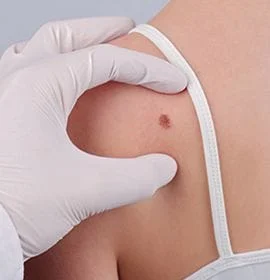
Moles
Moles are very common. In fact, almost all teenagers and adults have moles. They generally develop during childhood through young adulthood. They are made up of nevus (mole) cells growing in the skin. Normal moles are uniform in color, and can be flat or dome-shaped and raised. A mole present at birth is called a congenital nevus.
Atypical Moles
(also called Dysplastic or Clark’s Nevi)
Some people have Atypical Nevi. While these types of moles may look like melanoma, atypical moles are not cancerous. However, patients who tend to have atypical moles are at higher risk for melanoma than patients with no atypical moles. Although melanoma can develop from an atypical mole, most atypical moles do not turn into melanoma. In general, if a clinically atypical mole is not changing and the patient and practitioner do not suspect melanoma, an atypical mole does not have to be removed (but can easily be removed if the patient is worried). If a biopsy is performed and the pathology report demonstrates an atypical mole, the majority of dermatologists would recommend that moles with moderate or severe atypia should be completely removed.
Mole Removal
We offer many different mole removal services. We may be able to excise or cut your mole off without the need for stitches. If your mole is non-cancerous, there is no need to remove it other than aesthetic purposes. If your mole has uneven edges, or you notice it is growing in size or changing, please come in to have it examined. We will determine if it is suspicious and needs to be removed and tested.
Melanoma
Most people have heard of malignant melanoma, because this type of skin cancer can be deadly. If not caught and treated before it gets advanced, the cancerous cells in melanoma can metastasize (spread to other organs), and be harmful to the health. The goal is to identify a melanoma in the early stages, when it can be more easily treated, and prevent future metastasis.
Treatment of early, thin melanomas is easily done in our office, with an excision under local anesthesia. Deeper melanomas may warrant more extensive treatment, including lymph node examination, and we generally refer these patients to an oncologist or general or plastic surgeon.
Although most melanomas occur in fair skinned individuals, they can affect patients of any race. In addition, our practice has detected melanomas in non-sun-exposed locations, and even in children.
“A B C D E” Guidelines
What makes a mole suspicious for melanoma? This has been summarized as the "ABCDE" of melanomas, in which:
- A = Asymmetry of outline
- B = Border irregularity
- C = Color irregularity
- D = Diameter greater than 6 mm (larger than a pencil eraser)
- E = Enlargement of recent origin (or any change)
That is to say that most melanomas are fairly large and irregular in shape and color, while benign moles are generally small and symmetrically round or oval. A rapidly growing, itchy, bleeding or tender mole should arouse suspicion, but, conversely, most melanomas produce no symptoms. Things that increase risk include:
- - Two or more blistering sunburns before age 18
- - Fair skin, freckles and sensitivity to the sun
- - Having more than 50 moles
- - Having atypical moles
- - Having a parent, brother, sister or child with a melanoma
- - Having occasional intense sun exposure on weekends or on vacations
If you, a friend or loved one has many moles or a spot that is irregular, a physician should be consulted. If the physician is even slightly suspicious, an almost painless biopsy should be done so the lesion can be examined pathologically. Dozens of moles should be removed for each melanoma found so no melanomas are missed. Even the best dermatologists are only correct 3/4 of the time in diagnosing melanomas by just looking at them!
Even if you have no suspicious spots requiring a visit to the dermatologist, you should continue to examine your whole skin once a month using a hand mirror and a full-length wall mirror to better see your back. The sudden appearance of an irregularly pigmented flat spot is the most common early sign of a melanoma and should alert you to make an appointment with your doctor. At the same time, as you look at your skin, perform a monthly breast exam if you are a woman or testicle exam if you are a man. This should take a total of five minutes a month or one hour a year - time well spent. For a body map to track your moles, click here.
